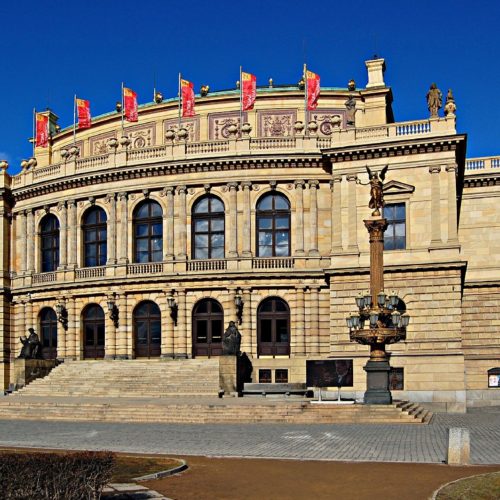
The construction of the Rudolfinum, a multi-purpose building whose concept was unique at the time, was initiated by Böhmische Sparkasse (Česká spořitelna). Founded in 1825, this savings bank was the oldest financial institution in the Kingdom of Bohemia. The prestigious building project bore witness not only to the financial strength and potential of Böhmische Sparkasse, but also to its self-confidence, sense of corporate social responsibility and belief in the supreme role of art. The new building was to be located on the right bank of the Vltava, just opposite the Prague Castle.
An early construction effort on the site had given rise to a riding hall; this was later replaced by a prison and Brosche’s chemical factory, which, in turn, gave way to a sawmill owned by the leading businessman Sir Vojtěch Lanna. Now it seemed the site would finally be used for a truly outstanding purpose. The exceptional status of the investor and the project itself is evident from the list of illustrious names that had been asked to take part in the architectural tender: A. V. Barvitius, V. Lunch, G. Niemann, O. Thienemann, V. I. Ullmann, A. von Wiellemans, J. Zítek and J. Schulz.
The jury, made up of leading architects of the day such as H. von Ferstel, T. von Hansen or F. von Schmidt, chose Zítek’s and Schulz’s project, even though contemporary opinions criticised it for having overly suppressed the required architectural unity of the building’s mass and outward appearance to clearly distinguish its two functionally differentiated parts: the concert premises and the gallery. The façade of the concert hall, with a rusticated elevated ground floor that is separated from the other floors by a string course, faces southwards to the present-day Jan Palach Square.
The façade is articulated by Ionic columns and topped by a balustrade decorated with vases and statues of famous musicians. The gallery part, with two monumental corner towers in its north façade, has the same decorative elements, which gives the building a unified visual appearance. The entrance in the west front, facing the Vltava embankment, leads to the impressive Ceremony Hall of the Rudolfinum, lined by 25 arches. The central ceremonial staircase leads up to the gallery rooms. Translucent ceilings ensure proper illumination of the collections.
Dvorak’s Hall
The world-famous concert hall has been the home stage of the Czech Philharmonic since the orchestra’s very first public performance on 4 January 1896, when it played here under the baton of Antonín Dvořák. The hall served its purpose until 1918 when a decision was taken to convert it into a plenary room for the new Czechoslovak parliament. Concert activities returned to Dvořák Hall in 1940–1942 under the project of architects Antonín Engel and Bohumír Kozák. Since then the hall has not seen any significant changes. Its central element is the organ, built according to Zítek’s and Schulz’s plans by Wilhelm Sauer from Frankfurt an die Oder.
The main concert hall of the Rudolfinum is suitable especially for symphonic, oratorio and chamber music performances. The Rudolfinum offers a state-of the-art recording studio for audio recordings and a high-quality organ.

Text & photos: Czech Philharmonic
